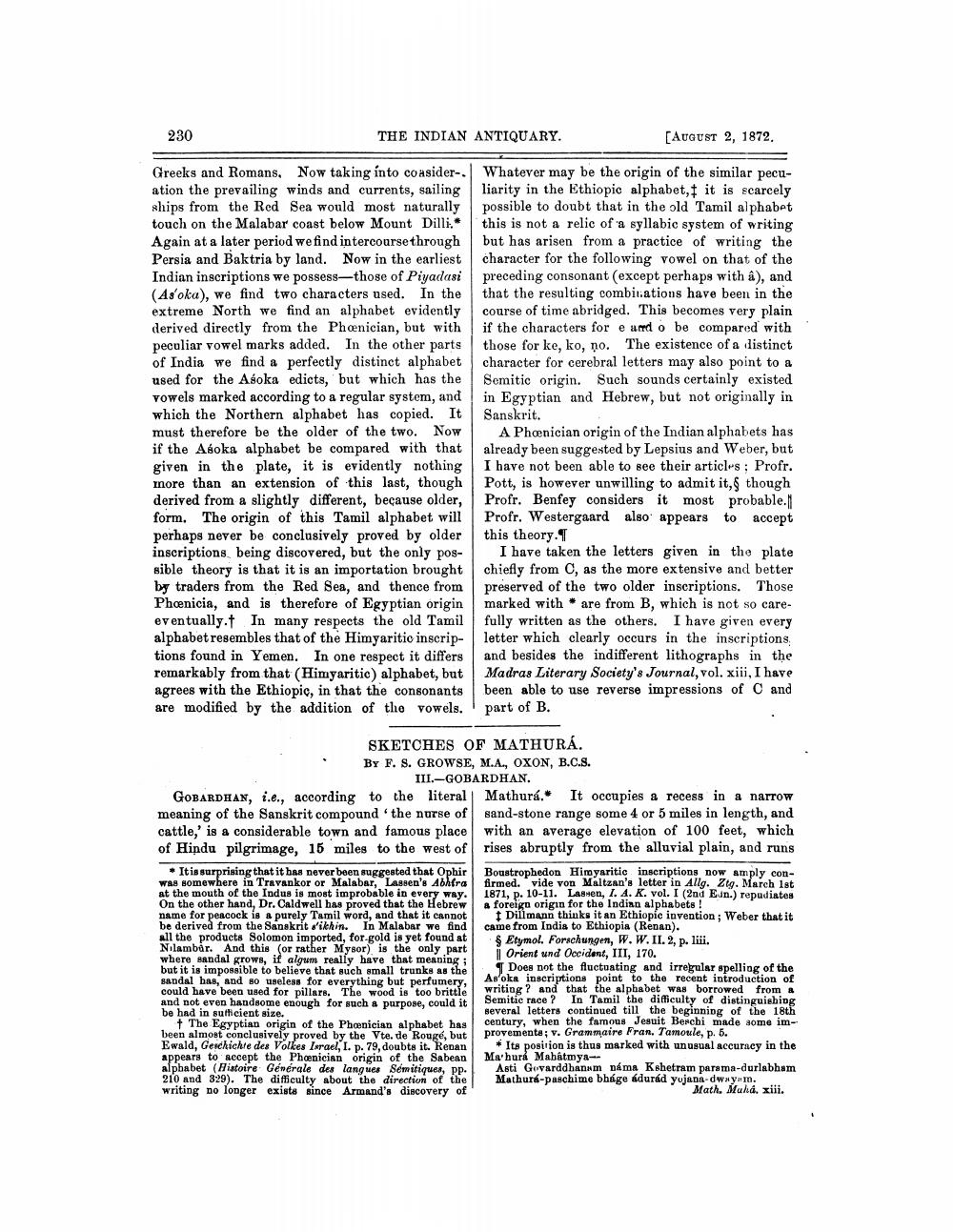________________
230
THE INDIAN ANTIQUARY.
[AUGUST 2, 1872.
Greeks and Romans. Now taking into coasider. Whatever may be the origin of the similar pecuation the prevailing winds and currents, sailing liarity in the Ethiopic alphabet, it is scarcely ships from the Red Sea would most naturally possible to doubt that in the old Tamil alphabet touch on the Malabar coast below Mount Dilli.* this is not a relic of a syllabic system of writing Again at a later period we find intercourse through but has arisen from a practice of writing the Persia and Baktria by land. Now in the earliest character for the following vowel on that of the Indian inscriptions we possess—those of Piyadasi preceding consonant (except perhaps with â), and (As'oka), we find two characters used. In the that the resulting combinations have been in the extreme North we find an alphabet evidently course of time abridged. This becomes very plain derived directly from the Phoenician, but with if the characters for e amd o be compared with peculiar vowel marks added. In the other parts those for ke, ko, no. The existence of a distinct of India we find a perfectly distinct alphabet character for cerebral letters may also point to a used for the Asoka edicts, but which has the Semitic origin. Such sounds certainly existed vowels marked according to a regular system, and in Egyptian and Hebrew, but not originally in which the Northern alphabet has copied. It Sanskrit. must therefore be the older of the two. Now A Phænician origin of the Indian alphabets has if the Asoka alphabet be compared with that already been suggested by Lepsius and Weber, but given in the plate, it is evidently nothing I have not been able to see their articles : Profr. more than an extension of this last, though Pott, is however unwilling to admit it, though derived from a slightly different, because older, Profr. Benfey considers it most probable.11 form. The origin of this Tamil alphabet will Profr. Westergaard also appears to accept perhaps never be conclusively proved by older this theory. I inscriptions being discovered, but the only pos- I have taken the letters given in the plate sible theory is that it is an importation brought chiefly from C, as the more extensive and better by traders from the Red Sea, and thence from preserved of the two older inscriptions. Those Phoenicia, and is therefore of Egyptian origin marked with * are from B, which is not so careeventually. In many respects the old Tamil fully written as the others. I have given every alphabet resembles that of the Himyaritio inscrip- letter which clearly occurs in the inscriptions, tions found in Yemen. In one respect it differs and besides the indifferent lithographs in the remarkably from that (Himyaritic alphabet, but Madras Literary Society's Journal, vol. xiii, I have agrees with the Ethiopic, in that the consonants been able to use reverse impressions of C and are modified by the addition of the vowels. part of B.
SKETCHES OF MATHURÁ. By F. S. GROWSE, M.A., OXON, B.C.S.
III.-GOBARDHAN. GOBARDHAN, i.e., according to the literal Mathura. It occupies a recess in a narrow meaning of the Sanskrit compound the nurse of sand-stone range some 4 or 5 miles in length, and cattle,' is a considerable town and famous place with an average elevation of 100 feet, which of Hindu pilgrimage, 15 miles to the west of rises abruptly from the alluvial plain, and runs
Itis surprising that it has never been suggested that Ophir Boustrophedon Himyaritic inscriptions now Amply conWas somewhere in Travankor or Malabar, Lassen's Abhfra firmed. vide von Maltzan's letter in Allg. Zt. March 1st at the mouth of the Indus is most improbable in every way. 1871, p. 10-11. Lasien, I. A. K. vol. I (2nd Eun.) repudiates On the other hand, Dr. Caldwell has proved that the Hebrew & foreign origin for the Indian alphabets ! name for peacock is a purely Tamil word, and that it cannot + Dillmann thinks it an Ethiopic invention : Weber that it be derived from the Sanskrit s'ikhin. In Malabar we find came from India to Ethiopia (Renan). all the products Solomon imported, for-gold is yet found at Etymol. Forschungen, W. W. II. 2, p. liii. Nilambur. And this (or rather Mysor) is the only part where sandal grows, if algum really have that meaning;
| Orient und Occident, III, 170. but it is impossible to believe that such small trunks as the
Does not the fluctuating and irregular spelling of the sandal has, and so useless for everything but perfumery,
As'oka inscriptions point to the recent introduction of could have been used for pillars. The wood is too brittle
writing? And that the alphabet was borrowed from & and not even handsome enough for such a purpose, could it
Semitic race? In Tamil the difficulty of distinguishing be had in sufficient size.
several letters continued till the beginning of the 18th + The Egyptian origin of the Phoenician alphabet has century, when the famous Jesuit Berchi made some imbeen almost conclusively proved by the Vte. de Rouge, but provemente; V. Grammaire Fran. Tamoule, p. 5. Ewald, Geschichte des Volkes Israel, I. p. 79, doubts it. Reban * Its position is thus marked with unusual accuracy in the appears to accept the Phoenician origin of the Sabean Ma'hura Mabátmyaalphabet (Histoire Générale des langues Sémitiques, pp. Asti Govardhanam náma Kshetram parama-durlabham 210 and 829). The difficulty about the direction of the Mathurs-paschime bháge ádurád yojana-dwxyam. writing no longer exists since Armand's discovery of
Math, Muhá. xiii.




